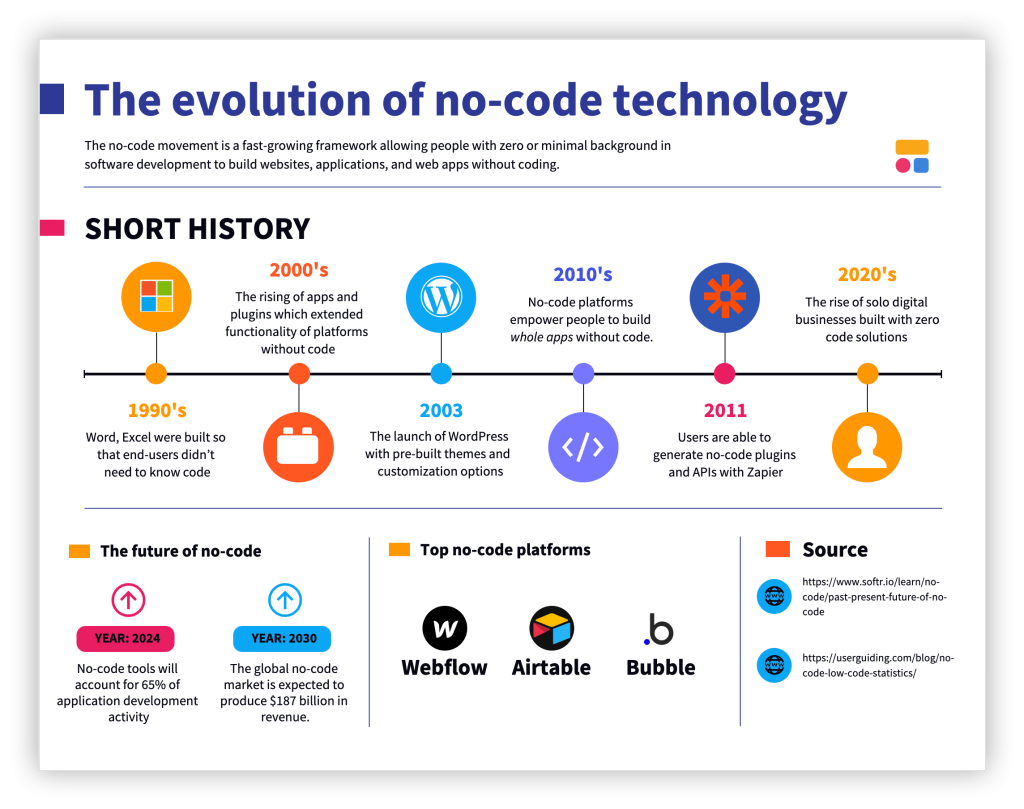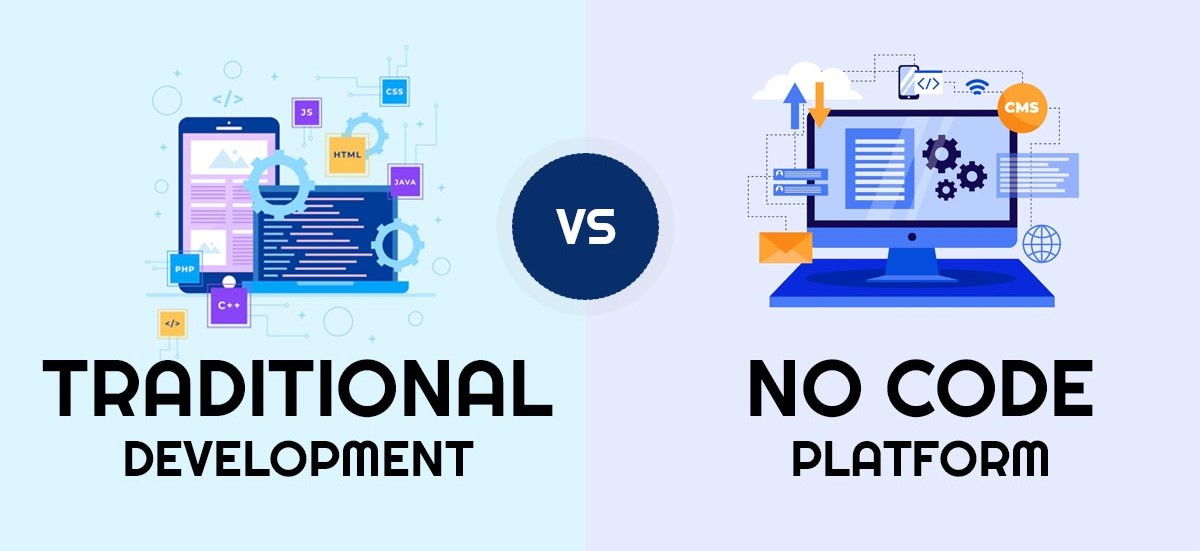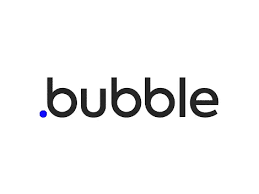No-Code Development is the Future: Successful Startups Using Bubble
In today’s fast-paced startup ecosystem, time and resources are critical factors that determine success. Traditional coding often demands extensive development time, high costs, and large teams, making it challenging for startups with limited resources to compete. This is where No-Code Development platforms like Bubble have made a significant impact, allowing entrepreneurs and startups to develop fully functional web applications without needing to write a single line of code.
Bubble empowers startups to launch their MVPs (Minimum Viable Products) faster, validate ideas, and iterate rapidly, enabling them to focus on growth rather than infrastructure. Throughout this article, we’ll explore several successful startups that used Bubble, a leader in No-Code Development, to build their web applications and scale their businesses. Additionally, we will discuss why No-Code Development platforms like Bubble are quickly becoming the future of web development.
For startups interested in exploring the full potential of Bubble, Bubble Developer offers comprehensive resources, expert advice, and tools to take your Bubble app to the next level, ensuring that No-Code Development can work for you.
1. Why Startups Are Turning to No-Code Platforms

No-Code Development platforms like Bubble are revolutionizing the way startups approach product development. The ability to build and iterate web applications without needing developers reduces the barrier to entry for many entrepreneurs. Here are the primary reasons why startups are increasingly choosing No-Code Development platforms like Bubble:
1.1 Cost Efficiency
Hiring a team of experienced developers is costly, particularly for early-stage startups operating on limited budgets. Bubble allows entrepreneurs to build complex web applications without hiring a full development team, significantly reducing upfront development costs. By relying on pre-built elements, drag-and-drop interfaces, and integrations, founders can allocate their budget more efficiently toward marketing, customer acquisition, and business development.
1.2 Faster Time to Market
In the competitive startup landscape, the ability to get your product to market quickly can be a significant advantage. With traditional development, building even a simple web application can take months. Bubble, on the other hand, enables founders to launch an MVP in a matter of weeks, allowing them to test their ideas, gather feedback, and iterate much faster.
1.3 Flexibility and Customization
Although Bubble is a no-code platform, it provides startups with a high level of customization. From databases and APIs to advanced workflows and third-party integrations, Bubble offers the flexibility needed to build fully customized web applications that meet the unique needs of a business. This makes it an ideal solution for startups looking for both scalability and control over their platform.
1.4 Scalability
Startups need platforms that can grow with them. No-Code Development on Bubble offers scalability, meaning as the user base grows, the infrastructure can expand without requiring a complete redevelopment of the platform. This is crucial for startups that anticipate rapid growth but don’t want to be slowed down by the need for constant reengineering.
1.5 Reduced Technical Debt
Technical debt—when a company builds software quickly but inefficiently, requiring future rework—is a common challenge for startups. Bubble’s intuitive and structured development environment allows entrepreneurs to avoid the pitfalls of poorly written code. This enables them to maintain long-term agility without accruing the high costs of technical debt.
For a deeper understanding of how to get the most out of Bubble, you can refer to Bubble Developer, which offers insights into optimizing Bubble apps for performance, scaling, and much more.
2. Successful Startups That Used Bubble
Here are some successful startups that took advantage of No-Code Development using Bubble:
2.1 Qoins: Tackling Debt Management
Qoins is a fintech startup that helps users pay off debt faster by rounding up everyday transactions and applying the spare change to their debts. When Qoins started, they needed a platform that could integrate payment gateways, user accounts, and advanced financial algorithms. Instead of building a platform from scratch using traditional code, they turned to Bubble. With Bubble, the team was able to create a secure and scalable app that handled thousands of transactions daily, all while keeping development costs low.
By leveraging Bubble’s ability to handle complex workflows and secure payments, Qoins quickly became a success, helping users eliminate millions of dollars in debt. The ability to develop quickly allowed them to focus on growth and customer acquisition rather than technical challenges.
2.2 Plato: A Mentorship Platform for Startups
Plato is a mentorship platform that connects startups with experienced mentors. The team behind Plato needed a solution that allowed them to match mentors and mentees, schedule sessions, and manage communications between them—all without building custom software. Using Bubble, Plato was able to create a fully functional mentorship platform with automated workflows for matching users, tracking progress, and enabling secure communication.
By choosing Bubble, Plato could launch their product swiftly, scale it based on user demand, and save thousands in development costs. Today, Plato is a thriving community, with startups from around the world utilizing the platform to gain mentorship from top industry experts.
2.3 Comet: A Freelance Marketplace for Tech Professionals
Comet is a freelance marketplace designed to connect tech professionals with companies looking for short-term hires. Initially, the founders of Comet needed a way to quickly build a marketplace that could handle job postings, applications, user profiles, and secure payments. Instead of building a custom solution, they opted for Bubble.
Using Bubble, Comet developed a dynamic marketplace that could scale to meet the growing demand for freelance tech talent. Today, Comet serves thousands of freelance professionals and companies, all without the traditional complexities of managing custom-built software.
These examples demonstrate how startups can leverage Bubble’s no-code platform to build and scale web applications that rival traditional software in complexity and functionality. For more examples and to explore how Bubble can work for your startup, visit Bubble Developer.
3. How to Scale a Startup with Bubble
Once a startup has built and launched its MVP using a No-Code Development platform like Bubble, the next step is scaling the application. Here’s how startups can ensure that their project developed through No-Code Development is ready for growth.
3.1 Optimizing Performance
One of the key concerns when scaling any web application is performance. Bubble provides tools to optimize app performance, such as database management, optimized workflows, and server capacity scaling. By using optimized queries and carefully structuring your app’s data, startups can ensure that their app remains fast even as traffic increases.
3.2 Scaling Infrastructure
Bubble allows startups to scale their server infrastructure as they grow. As the number of users increases, so can the server capacity, without any need for manual intervention. This means startups can focus on acquiring more users without worrying about whether their app can handle the traffic.
3.3 Adding New Features
Bubble’s modular approach to app building makes it easy to add new features without rewriting the existing codebase. Whether you’re adding a new payment method, integrating a third-party API, or building a new user interface, Bubble’s flexibility allows you to iterate and expand quickly.
3.4 Leveraging APIs
As startups grow, they often need to integrate third-party services like CRMs, marketing tools, and payment gateways. With Bubble’s API connector, startups can take advantage of No-Code Development to extend their app’s functionality without needing custom-built solutions.
3.5 Managing User Growth
As user numbers grow, it’s essential to implement strategies to manage increased traffic and data loads. Bubble allows for the implementation of load balancing, caching, and data optimization techniques that ensure smooth performance as the user base expands.
For startups looking to gain deeper insights into scaling their applications built through No-Code Development, Bubble Developer offers detailed guides and valuable resources.
4. Future Trends in No-Code Development

The no-code movement is transforming the software development landscape, and it shows no signs of slowing down. Startups, in particular, are at the forefront of this revolution. Here are some of the trends shaping the future of no-code development:
4.1 Democratization of App Development
The No-Code Development movement is transforming the software development landscape, and it shows no signs of slowing down. Startups are leading the way in this revolution. Here are some of the trends shaping the future of No-Code Development:
4.2 Integration with AI and Machine Learning
As AI and machine learning technologies become more prevalent, no-code platforms are beginning to integrate these capabilities. Startups will soon be able to build AI-driven applications without needing deep technical expertise. Bubble is already making strides in this area by offering API integrations with AI services, and we can expect more features like this in the future.
4.3 Enterprise Adoption of No-Code
While no-code platforms have traditionally been seen as tools for startups and small businesses, enterprises are starting to adopt these platforms as well. Large companies are recognizing the value of using no-code for internal tools, rapid prototyping, and even customer-facing applications. As no-code platforms like Bubble continue to grow in sophistication, enterprise adoption will likely accelerate.
4.4 Collaboration Between No-Code and Traditional Development
The future of app development will likely involve a hybrid approach, where no-code platforms work alongside traditional development. Startups might use no-code for their MVP, and as they scale, they might integrate traditional code for more advanced features. This combination allows startups to benefit from the speed and flexibility of no-code, while still being able to tap into the power of custom development when necessary.
For startups looking to stay ahead of these trends, Bubble Developer is an excellent resource for exploring how to integrate no-code solutions with cutting-edge technologies.
Conclusion
Bubble has proven itself to be a powerful tool for startups looking to build and scale web applications quickly and cost-effectively. As demonstrated by successful companies like Qoins, Plato, and Comet, the platform offers the flexibility, scalability, and customization that startups need to thrive in today’s competitive market.
With the rise of the no-code movement, platforms like Bubble are poised to continue reshaping the future of web development. Whether you’re building an MVP or scaling a full-fledged product, no-code platforms can provide the tools you need to succeed.
For entrepreneurs ready to dive into the world of no-code, resources like Bubble Developer offer the guidance and expertise needed to make the most of Bubble. The future of app development is here, and it’s more accessible than ever.






